
Steps to close a facility safely
If you need or are required to shutdown a facility temporarily, there are several steps you can follow to protect your property and help ensure your building is in good condition when it’s time to reopen.
Building security
- Ensure all windows, doors, and access points (including roof hatches) are locked and fully secured.
- Activate all burglar alarm systems including motion and door detection.
- Ensure all lighting on the exterior of the property is operational and active.
- Secure all gates and ensure fencing is in good condition and securely installed.
- Ensure all CCTV and video security equipment is operational and active for both the interior and exterior of the building. All recordings should be saved to a cloud server for a minimum of two weeks. Otherwise, onsite video backup should be in use.
- Schedule all data backups to run.
- Remove any cash or high-value materials or secure them in safes, vaults, etc.
Water damage prevention
- Ensure heating systems are operational and that heat is maintained at a minimum of 50 degrees inside the building to prevent freezing of plumbing and sprinkler pipes. In warmer climates ensure the air conditioning is set to 80 degrees to protect against humidity and mold growth.
- Shut off all water supply lines underneath individual sinks and toilets. If unable to do this, ensure all sink taps are in the off position and no toilets are “running.”
- Install a monitored leak and temperature detection system. The Hanover offers a leak and temperature detection solution.
- Check that all sump pumps, if applicable, are operational and functioning properly.
- Clear all gutters and downspouts of debris.
- Repair any roof leaks, if present.
Fire prevention
- Ensure all fire detection systems and fire sprinkler systems are active and alarm monitored.
- Ensure access to the sprinkler riser and valves is accessible by emergency personnel.
- Fire sprinkler system control valves should be chained/locked or monitored by a control valve alarm.
- If a fire pump is present and liquid fueled, ensure that the fire pump fuel tank is full.
- If a fire suppression suction tank is present, ensure the tank has adequate water.
- Any fire hydrants on the property should be clear and the surrounding area accessible.
- Move combustible materials away from heat sources or electrical equipment.
- With the exception of electrical, heating, and building maintenance equipment, properly shut down any non-essential production or other equipment/systems.
- Move dumpsters and any combustible materials on the exterior of the building to at least 50 feet from the building structure.
- If possible and already in small containers, remove all chemicals and/or flammable liquids from the building.
- Keep lockboxes (if applicable) in a location that is readily visible and operational for fire department access.
- Clear debris and vehicles from interior and exterior entrances, lots and surrounding areas of the building to enable quick access for emergency personnel.
- Close all fire doors or ensure all self-closing mechanisms are in working condition and operational.
Management controls
- Provide the fire and burglar alarm company with updated business contact information.
- Ensure all keys or access cards for exterior doors are accounted for and with the appropriate persons.
- Remove all food and other items that may attract pests or rodents.
- Continue care of landscaping. This shows that the owner is still monitoring the property and also reduces the fire risk.
- As allowed by state and local authorities, regularly visit the property to check the condition.
This material is provided for informational purposes only and does not provide any coverage or guarantee loss prevention. The examples in this material are provided as hypothetical and for illustration purposes only. The Hanover Insurance Company and its affiliates and subsidiaries (“The Hanover”) specifically disclaim any warranty or representation that acceptance of any recommendations contained herein will make any premises, or operation safe or in compliance with any law or regulation. By providing this information to you, The Hanover does not assume (and specifically disclaims) any duty, undertaking or responsibility to you. The decision to accept or implement any recommendation(s) or advice contained in this material must be made by you.

